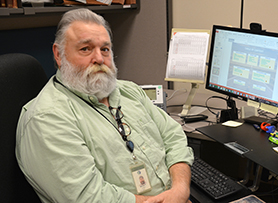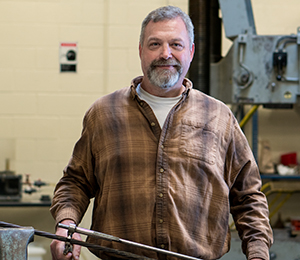By Sue Roe

Mike Leegard, contract administration engineer in the office of Construction and Innovative Contracting, brought the idea of the Knowledge Book to MnDOT. Photo by Sue Roe |
When Todd Niemann and Gordy Bruhn retire from MnDOT in a few years, the knowledge and technical expertise they acquired during their careers won’t leave the agency when they do. Instead, it will be captured in a knowledge-retention project known as the Knowledge Book.
“The Knowledge Book is for those deep technical experts with unique knowledge that would be hard to replace,” said Mike Leegard, contract administration engineer in the office of Construction and Innovative Contracting. “MnDOT has always worried about its experts walking out the door, so this idea is to talk them within their last two to five years of employment.”
Leegard is leading the project, which started four years ago, and so far, Niemann, Bruhn and Dave Linell, who is now retired, have either completed or are nearing completion on their Knowledge Book.
The project uses the Method for Analyzing and Structuring Knowledge, or MASK method, first developed in France for the French Atomic Energy Commission. MnDOT hired French expert Jean-Francois Tendron to use this methodology to conduct in-depth interviews and to develop interactive PowerPoint-based Knowledge books.
Niemann is a structural materials engineer who has worked in the bridge office for 27 years. Most of MnDOT’s engineering needs are from the civil engineering field, but Niemann is the agency’s only metallurgical engineer with steel bridge fabrication, construction and maintenance expertise.

Gordy Bruhn is an engineering specialist in the field of concrete pavement rehabilitation and repair. Photo by Charles Ombati |
Bruhn is an engineering specialist and expert in the field of concrete pavement rehabilitation and repair. He started at MnDOT in 1986 and worked as a maintenance laborer, technician in pre-stress concrete and construction inspector.
Dave Linell retired as a mix design specialist in the bituminous office in 2017. He worked for MnDOT for more than 40 years as an expert in the chemical, asphalt, aggregate, geotechnical and concrete laboratories.
Tendron interviewed all three men either in face-to-face or Skype interviews for many hours. Tendron is skilled at asking probing questions in a structured way that results in identifying critical knowledge.
Niemann had 20 interviews and Bruhn had at least eight interviews. Each interview was three to four hours.
“It’s a different process to talk about myself and figure out what parts of what you know are the most useful,” Niemann said. “I’ve had a fortunate career where I’ve become a specialist for the department in this technical area. I wanted the book to be helpful to the agency as I transition into retirement.”
The finished product is an interactive PowerPoint with drawings, maps, photos, video and audio. The power points will be recreated in an e-learning format for easy mobile and iPad viewing. The reformatted Knowledge Books will be available on the knowledge retention project page.
“Gordy’s book is about how he analyzes a concrete rehabilitation project. Dave’s book is about how to identify aggregates and bituminous mix design. Todd’s book is very specific to steel construction. The commonality with them all is the capture of their intellectual knowledge,” said Leegard. “They’re jewels of knowledge.”
He said the books are never really finished because others, who are tapped as the caretakers or successors of the books, will take ownership and continue to add to the knowledge.
“To keep the books relevant, the legacy of information gets passed on,” Leegard said.
John Garrity, bituminous engineer, who helped Linell with his book and is now its caretaker, said the value of the book lies in passing along Linell’s technical knowledge.
“He worked in every lab here in the Office of Materials and Road Research. His expertise and understanding of aggregates and his knowledge of the functionality of the various labs here made him invaluable in his position as a mix design specialist, Garrity said. “You don’t find people with that broad-based knowledge anymore.”
Bruhn said when his Knowledge Book is done it will provide a new person coming in with 50 to 60 percent of the knowledge to make good decisions on concrete rehabilitation and repair.
“On-the-job training will get them the rest of the way,” he said. “To be an effective concrete person you need to know the actual construction steps taken with that pavement 20 years before.”
The books are the first three in the U.S. in the public sector. Kraft Foods has also adopted the method.
MnDOT worked with South Central College to do the international contracting and to develop more MASK consultants in the U.S.
Leegard said there are other ways to do knowledge transfer within an organization, but the Knowledge Book is an easy-to-follow and intuitive method.
“If it’s good enough for people in nuclear power plants, it will work here at MnDOT,” he said.
About 31 percent of MnDOT’s workforce is or will be retirement eligible within the next five years, so Leegard said doing more Knowledge Books should be a priority so MnDOT’s technical expertise continues to be preserved.
The Knowledge Retention Pilot Project started as a research project. For more information contact Leegard, who was the technical liaison. |



